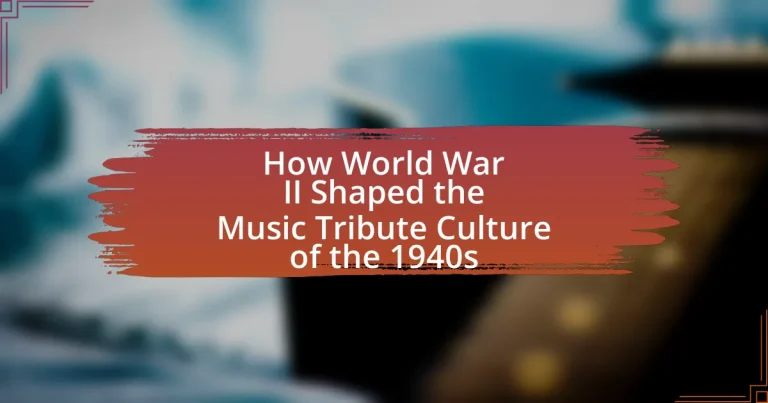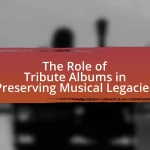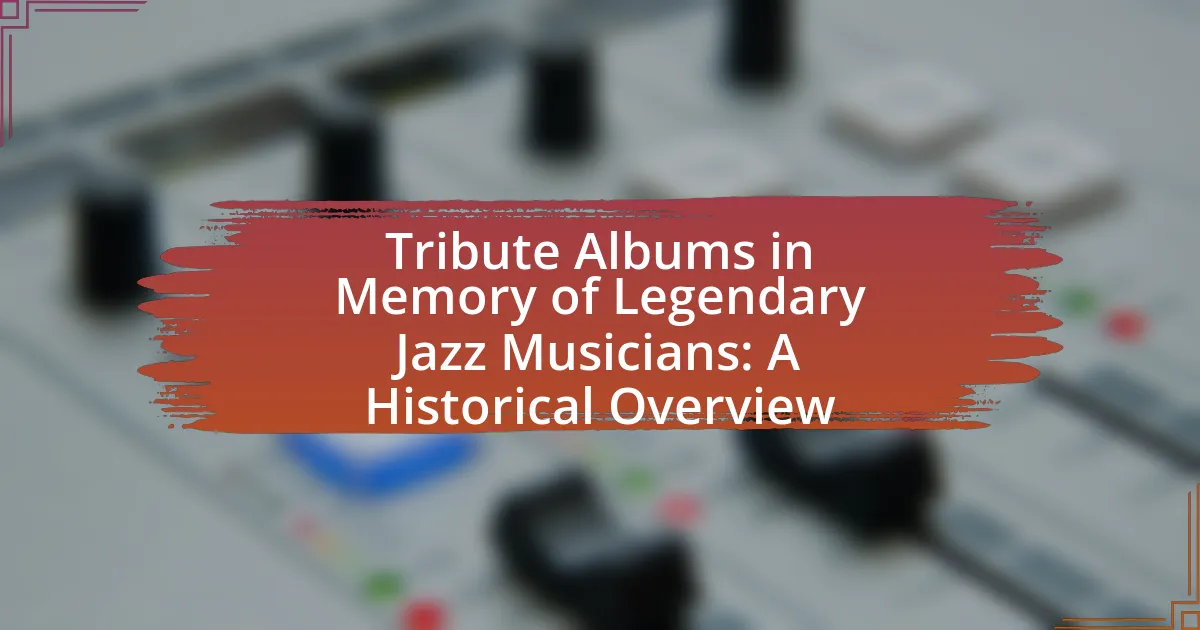World War II played a pivotal role in shaping the music culture of the 1940s, leading to the rise of genres such as swing, jazz, and big band music, which became symbols of hope and resilience. The war catalyzed the popularization of radio, allowing artists like Glenn Miller and Duke Ellington to reach broader audiences, while the emotional experiences of soldiers and civilians were reflected in the lyrics of wartime songs. Music served as a crucial tool for morale and propaganda, with tributes honoring military service and addressing themes of loss and patriotism. The legacy of this era established a framework for future music tribute cultures, influencing how subsequent generations engage with music as a means of remembrance and emotional expression.
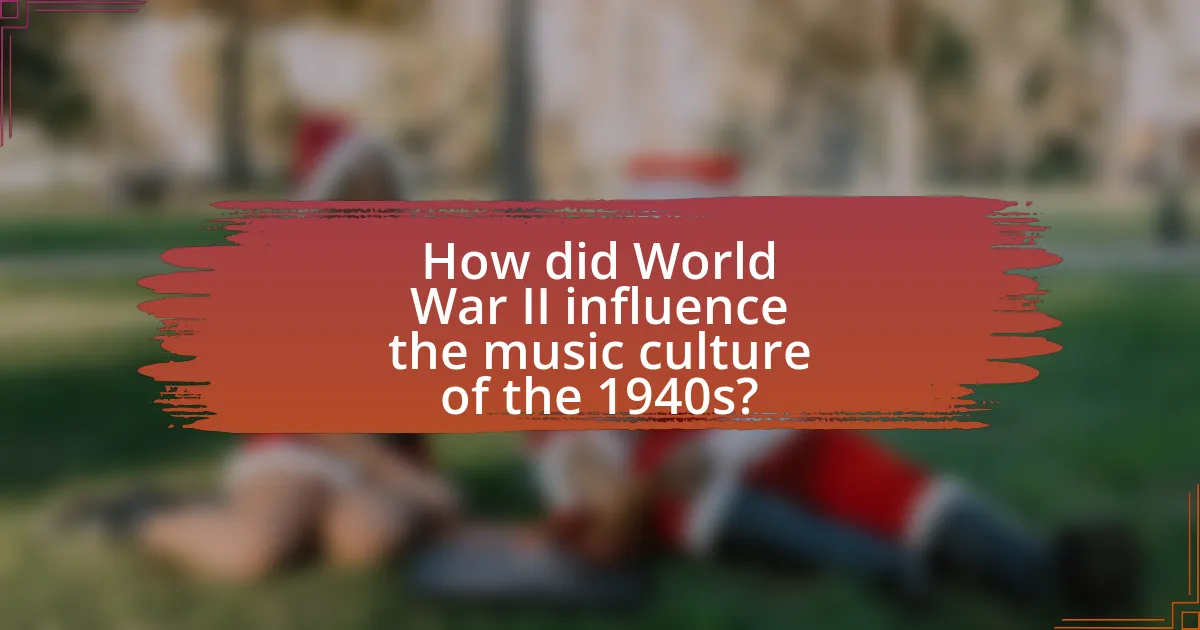
How did World War II influence the music culture of the 1940s?
World War II significantly influenced the music culture of the 1940s by fostering the rise of genres such as swing, jazz, and big band music, which became symbols of hope and resilience during the war. The war effort led to the popularization of radio as a primary medium for music dissemination, allowing artists like Glenn Miller and Duke Ellington to reach wider audiences. Additionally, the emotional experiences of soldiers and civilians alike were reflected in the lyrics and themes of songs, with many compositions addressing love, loss, and patriotism. The wartime environment also encouraged the emergence of new musical styles, such as rhythm and blues, which laid the groundwork for future genres. This transformation in music culture was further evidenced by the significant number of songs written specifically for the war, including “We’ll Meet Again” by Vera Lynn, which became an anthem for soldiers and their families.
What role did music play during World War II?
Music served as a crucial tool for morale and propaganda during World War II. It provided comfort to soldiers and civilians alike, fostering a sense of unity and resilience in the face of adversity. Songs like “We’ll Meet Again” by Vera Lynn became anthems of hope, while military marches and patriotic tunes were used to boost enlistment and support for the war effort. The U.S. government utilized music in radio broadcasts to disseminate information and maintain public spirit, exemplified by the Armed Forces Radio Network, which played a significant role in keeping troops connected to home. Additionally, music reflected the cultural sentiments of the time, with genres like swing and jazz evolving to express the complexities of wartime experiences.
How did wartime experiences shape musical themes and lyrics?
Wartime experiences significantly shaped musical themes and lyrics by reflecting the emotional and social realities of conflict. Songs from World War II often conveyed themes of loss, longing, and patriotism, resonating with the experiences of soldiers and civilians alike. For instance, tracks like “We’ll Meet Again” by Vera Lynn encapsulated the hope of reunion amidst separation, while “Boogie Woogie Bugle Boy” by The Andrews Sisters celebrated the spirit of American soldiers. These songs served not only as morale boosters but also as a means of processing grief and uncertainty, illustrating the profound impact of war on artistic expression.
What genres of music became popular during the war?
Jazz and swing music became popular during World War II. These genres provided a sense of escapism and morale-boosting entertainment for both soldiers and civilians. The rise of big bands, such as those led by Glenn Miller and Duke Ellington, exemplified this trend, as their music was widely broadcasted on the radio and played at dance halls, contributing to the cultural landscape of the 1940s. Additionally, the popularity of patriotic songs and ballads, like “We’ll Meet Again” by Vera Lynn, further reflected the emotional climate of the time, resonating with audiences facing the challenges of war.
How did the war impact musicians and composers?
The war significantly impacted musicians and composers by altering their creative output and opportunities. Many artists were drafted or volunteered for military service, which disrupted their careers and led to a shift in focus towards themes of patriotism, sacrifice, and loss in their music. For instance, composers like Benjamin Britten and Dmitri Shostakovich responded to the war’s horrors through works that reflected the emotional and social turmoil of the time. Additionally, the war spurred the creation of propaganda music, which aimed to boost morale and support the war effort, exemplified by songs like “We’ll Meet Again” by Vera Lynn. This period also saw an increase in collaboration among musicians across different genres, as they sought to unify audiences in a time of crisis.
What challenges did artists face during World War II?
Artists faced significant challenges during World War II, including censorship, resource scarcity, and the impact of war on their creative environments. Censorship limited artistic expression, as governments imposed restrictions on content deemed inappropriate or anti-war. Resource scarcity affected the availability of materials, making it difficult for artists to create and distribute their work. Additionally, the war disrupted traditional venues for performance and exhibition, forcing artists to adapt to new circumstances, often leading to a decline in opportunities for public engagement. These factors collectively hindered the ability of artists to fully express their creativity and connect with audiences during this tumultuous period.
How did military service affect the careers of musicians?
Military service significantly impacted the careers of musicians by providing them with unique opportunities for exposure and growth. Many musicians enlisted or were drafted during World War II, which led to performances for troops and increased visibility through military bands. For instance, artists like Glenn Miller and Duke Ellington gained fame by entertaining soldiers, which expanded their audiences and solidified their legacies. Additionally, the wartime experience influenced their music, often incorporating themes of patriotism and resilience, which resonated with the public and shaped the music tribute culture of the 1940s.
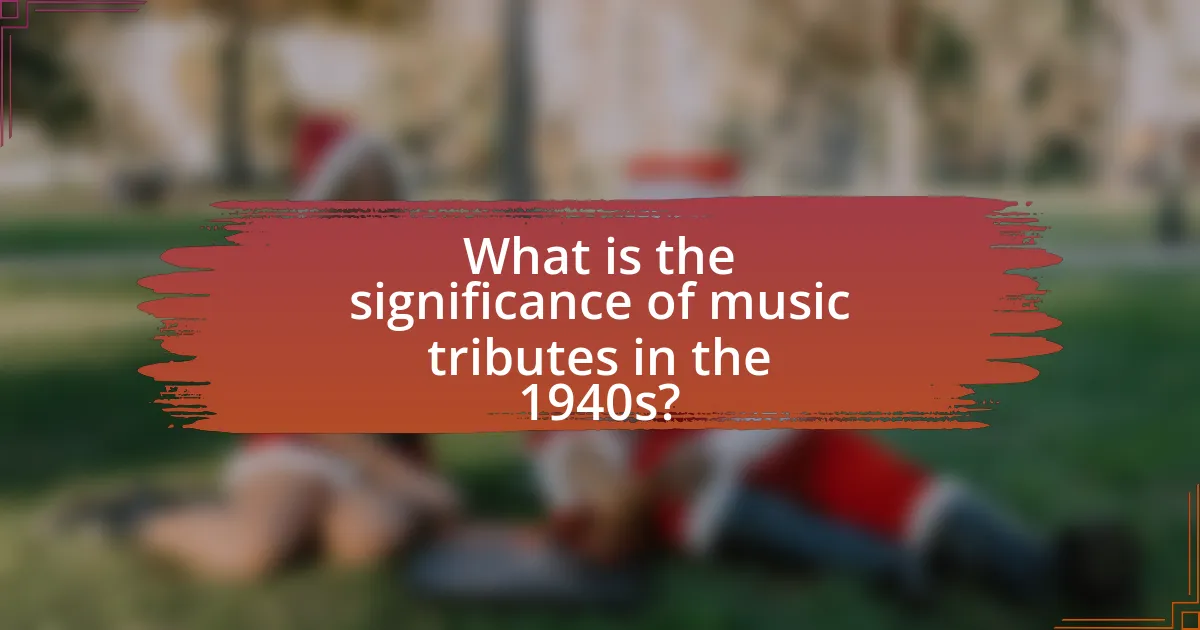
What is the significance of music tributes in the 1940s?
Music tributes in the 1940s served as a vital means of honoring those who served in World War II and reflecting the emotional landscape of the era. These tributes provided solace and unity during a time of widespread loss and uncertainty, allowing communities to come together in remembrance and support. For instance, songs like “I’ll Be Home for Christmas” resonated deeply with soldiers and their families, encapsulating the longing for home and the sacrifices made. The significance of these tributes is further underscored by their role in shaping popular culture, as they influenced the music industry and inspired future generations of artists to create works that honor military service and sacrifice.
How did music tributes emerge as a cultural phenomenon?
Music tributes emerged as a cultural phenomenon during World War II as a means of honoring fallen soldiers and boosting morale among civilians. The war created a collective sense of loss and sacrifice, prompting artists to create songs that paid homage to those who served and died. For instance, songs like “I’ll Be Home for Christmas” resonated deeply with families separated by the war, reflecting their longing and grief. This trend was further amplified by radio broadcasts and live performances, which became platforms for these tributes, allowing them to reach a wide audience and solidify their cultural significance. The emotional connection fostered by these tributes helped to shape a new genre of music that combined patriotism with personal loss, establishing a lasting legacy in American music culture.
What events or movements sparked the creation of music tributes?
The events of World War II significantly sparked the creation of music tributes, as artists sought to honor soldiers and express collective grief and resilience. The war led to a surge in patriotic songs and memorial pieces, reflecting the emotional landscape of the time. For instance, songs like “We’ll Meet Again” by Vera Lynn became anthems of hope and remembrance, resonating with both soldiers and civilians. This cultural response to the war laid the groundwork for a tradition of music tributes that continued in subsequent decades, as artists used their platforms to commemorate significant events and figures.
How did music tributes reflect societal sentiments of the time?
Music tributes during World War II reflected societal sentiments by expressing collective grief, patriotism, and resilience. For instance, songs like “We’ll Meet Again” by Vera Lynn resonated with families separated by war, encapsulating hope and longing, which mirrored the emotional landscape of the time. Additionally, the use of music in wartime propaganda, such as “The White Cliffs of Dover,” served to bolster national morale and unity, illustrating how music became a vehicle for shared experiences and emotions among the populace. These tributes not only provided comfort but also reinforced a sense of identity and purpose during a period marked by uncertainty and sacrifice.
What types of music tributes were prevalent in the 1940s?
In the 1940s, music tributes primarily included patriotic songs, memorials for fallen soldiers, and tributes to popular artists who contributed to the war effort. Patriotic songs like “God Bless America” and “The White Cliffs of Dover” served to boost morale and honor military personnel. Memorials often took the form of songs dedicated to specific soldiers or groups, reflecting the collective grief and respect for those who served. Additionally, tributes to artists such as Glenn Miller, who was lost during the war, highlighted the cultural impact of music on society during this tumultuous period. These tributes were significant in shaping the emotional landscape of the era, as they connected music with national identity and collective memory.
What are some notable songs that served as tributes during this era?
Notable songs that served as tributes during the World War II era include “We’ll Meet Again” by Vera Lynn, which became an anthem of hope for soldiers and their families, and “The White Cliffs of Dover,” also by Lynn, symbolizing longing and resilience. Additionally, “Boogie Woogie Bugle Boy” by The Andrews Sisters celebrated the contributions of the military, while “Praise the Lord and Pass the Ammunition” by Kay Kyser highlighted the spirit of perseverance. These songs resonated deeply with the public, reflecting the emotional landscape of the time and honoring those who served.
How did different genres contribute to the tribute culture?
Different genres significantly contributed to the tribute culture by reflecting the diverse experiences and emotions of World War II. For instance, jazz and swing music provided a sense of escapism and hope, while folk music often conveyed the struggles and sacrifices of soldiers and their families. The emergence of rhythm and blues during this period also highlighted the contributions of African American artists, who used their music to honor fallen heroes and express resilience. These genres collectively shaped the tribute culture by creating a rich tapestry of musical expressions that resonated with the public, fostering a sense of unity and remembrance in the aftermath of the war.

How did the legacy of World War II shape future music tribute cultures?
The legacy of World War II significantly shaped future music tribute cultures by establishing a framework for honoring collective experiences and sacrifices through music. This period saw the emergence of songs that reflected themes of loss, resilience, and patriotism, such as “We’ll Meet Again” by Vera Lynn, which became an anthem of hope for soldiers and their families. The widespread use of music in memorials and commemorative events post-war solidified its role as a medium for collective mourning and celebration, influencing later tribute cultures, including those for Vietnam veterans and 9/11 memorials. The integration of music into these cultural practices can be traced back to the emotional responses elicited during and after World War II, demonstrating how the war’s legacy created a lasting tradition of using music to honor and remember.
What lasting impacts did the 1940s music tribute culture have on later decades?
The 1940s music tribute culture significantly influenced later decades by establishing a framework for honoring artists and genres, which became a staple in music events and media. This culture, rooted in the emotional responses to World War II, led to the creation of tribute concerts and albums that celebrated iconic musicians, such as the post-war tributes to jazz and swing artists. The practice of honoring musicians through dedicated events and recordings became prevalent in the 1960s and 1970s, as seen in events like the Woodstock Festival and the rise of tribute bands. Additionally, the 1940s set a precedent for the music industry to recognize and celebrate musical legacies, which is evident in the continued popularity of tribute shows and awards, such as the Grammy Awards’ tribute performances. This legacy of honoring musical contributions has persisted, shaping the way contemporary music culture engages with its history and artists.
How did the themes of World War II influence music in subsequent wars?
The themes of World War II significantly influenced music in subsequent wars by embedding narratives of sacrifice, resilience, and patriotism into songs. For instance, during the Vietnam War, artists like Bob Dylan and Joan Baez drew upon the emotional weight of World War II songs to express anti-war sentiments and highlight the human cost of conflict. The use of music as a tool for social commentary became prevalent, reflecting the disillusionment that followed the idealism of World War II. Additionally, the incorporation of military motifs and the remembrance of fallen soldiers in songs from later conflicts, such as the Gulf War and the War on Terror, can be traced back to the musical traditions established during World War II, where songs like “We’ll Meet Again” resonated with themes of hope and reunion. This continuity illustrates how the emotional and thematic frameworks developed during World War II shaped the musical landscape of later wars, reinforcing the role of music as a means of processing collective trauma and expressing national identity.
What lessons can contemporary musicians learn from the tribute culture of the 1940s?
Contemporary musicians can learn the importance of community engagement and emotional resonance from the tribute culture of the 1940s. During this era, musicians often paid homage to wartime heroes and significant cultural figures, fostering a sense of unity and shared experience among audiences. This practice not only honored individuals but also created a collective identity, as seen in the popularity of songs like “We’ll Meet Again” by Vera Lynn, which provided comfort and hope during uncertain times. By embracing similar tribute practices today, contemporary musicians can strengthen their connection with audiences, evoke powerful emotions, and create a sense of belonging, thereby enhancing their artistic impact and relevance.
What are some best practices for creating meaningful music tributes today?
To create meaningful music tributes today, it is essential to focus on authenticity, emotional connection, and cultural relevance. Authenticity ensures that the tribute reflects the true essence of the artist or event being honored, which can be achieved by incorporating original elements of the artist’s style or significant themes from their work. Emotional connection can be fostered by selecting songs that resonate deeply with the audience, often evoking shared memories or experiences related to the artist. Cultural relevance is crucial, as it allows the tribute to engage with contemporary issues or sentiments, making it more impactful. For instance, tributes that address themes of resilience or unity can resonate strongly in today’s social climate, similar to how music during World War II often reflected the collective experiences of struggle and hope.
